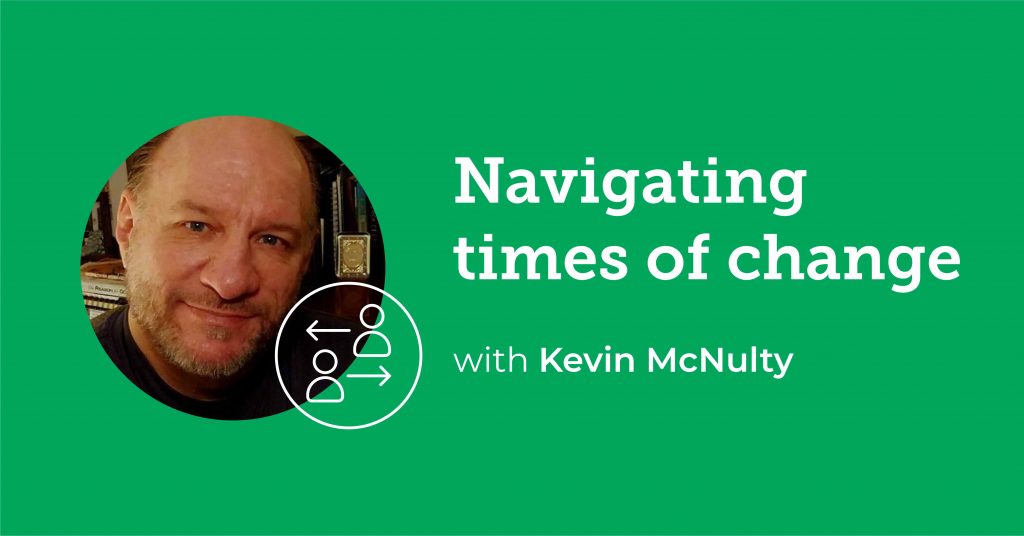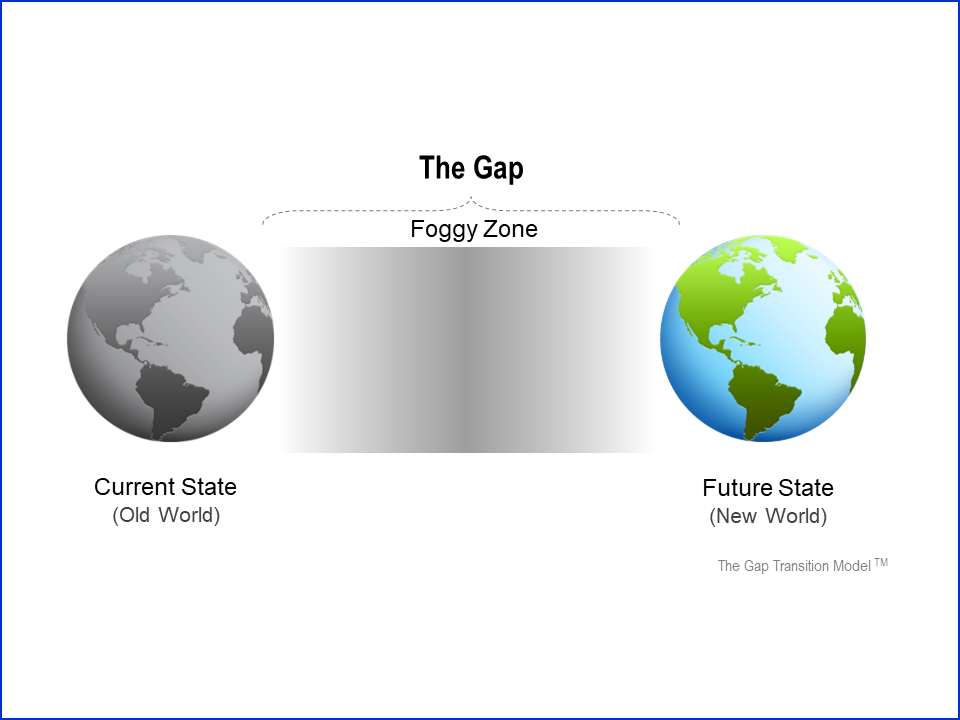Navigating times of change with Kevin McNulty
Throughout a person’s life they are met with many transitions. And regardless of a significant life change being positive or negative, people can struggle between their familiar old world and the unknown. This is particularly true for employees throughout their career cycle. New jobs, department transfers, role redefinitions – work naturally lends itself to alteration. So how can employers help support staff during these murky periods of uncertainty? And with COVID creating the biggest change for organizations, how can leaders provide stability?
Luckily, we have some expert advice! Kevin McNulty is a speaker, coach and author of “The Gap Between Two Worlds” – a book that guides readers on how to turn difficult life transitions into personal growth experiences. Kevin was recently a guest on our weekly show, The Shortlist, but was also kind enough to partake in an insightful Q&A about this very topic. Let’s dig in!

Q1. Kevin, your book is called “The Gap Between Two Worlds.” Can you explain to us what the gap is – especially in relation to employees, leaders and organizations?
“The Gap Between Two World” is a metaphor for change and transition. My book was written with respect to personal transition, but the principles are the same for any type of transition, including organizational change. The gap represents that space between the old and new worlds. It constitutes everything we experience when we face changes, challenges and transitions that occur during our lifetime. More robustly, the gap involves three major parts that apply to any transition, large or small.
- Old World – This is our current state, or perhaps our old life, the way things are or used to be; the known, the familiar, and the predictable.
- New World – This is the future state, the way things will be; the unknown, the uncharted, the unpredictable, and the unrevealed life into which we will eventually arrive.
- The Gap – This is that space between the old and the new worlds. We must navigate this period of transition between our two worlds.
As you transition, you will enter what’s known as the foggy zone. It is made up of those elements that can cause transition to be difficult. Things like emotions, disorientation, ambiguity, lack of vision, one’s ability to cope, skills, etc. The density of this fog depends on variables that led to the transition. For instance, think about consciously leave one job for another. You have time to plan in this scenario. Perhaps it’s similar work? And it’s very near to your home? Your fog in this case is light because it was an easier transition. If, however, after 15 years with a company you are unexpectedly let go, have low job prospects and no money in savings, then the fog may be very thick.

Q2. On The Shortlist, you mention proactiveness, communication and being revisionary as key traits for navigating through the gap. Can you give us some insight into each of these?
Yes! And proactiveness is not only a practice, but also a mindset. Too often people, teams, workplaces, and organizations are just the opposite – they are reactive. Of course, sometimes we must be reactive, as was the case of this pandemic. However, if you, your people and your organization have instilled “proactivity” as a mindset and culture, even the reaction can be “proactive” (if you will). During times of change and transition, proactive and solutions-oriented people recognize that they must understand the problem and then move to solutions as quickly as possible.
You can train your people to be this way by fostering a proactive and solutions-oriented mindset and culture. One simple way of doing this is when people bring you problems, challenge them to think for themselves. Simply ask: “what do you think we should do?” Repeat this enough and people will start bringing ideas and solutions. And in times of change, this will be a natural inclination.
In terms of communication, this is among the top practices that a leader must deploy, particularly during times of change and transition. One of the key premises to understanding the Gap is what I mentioned earlier – knowing that it involves a foggy zone, rife with disorientation and ambiguity. Whoever is leading the way should constantly and consistently be communicating to the followers: “here’s where we’re going; here’s how we’re going to get there; watch that bump in the road.”
With revisioning, to some degree that’s a play on words. It goes with the notion that when things change – depending on the change – one may not be completely redesigning or re-envisioning their entire life or organization. But rather, “revising.” People, teams and employees understand revising – it’s practical and less intimidating.
Q3. You used a powerful phrase on the show in relation to facing change: “the tyranny of the urgent.” Creating positive culture, cultivating trust and improving communication – it all takes time and effort, doesn’t it?
YES!!! As a coach and consultant, this is what I’m observing with people, both in their personal and professional lives. Entire organizational cultures seem to be dominated by the tyranny of the urgent. Among the many problems this leads to is that the important things fall to the wayside. Things like proactiveness, communication, relationship building, work-life balance, morale/positive culture, etc. All those things that leaders put on a poster and claim: “Our company values.”

Q4. We spoke a bit about mindset on The Shortlist, but how important is it for leaders to accept and embrace that some people approach change differently?
Frankly, it’s a fact of life. Now of course, this doesn’t mean that leaders must capitulate to every demand of their workforce. They obviously have many things to consider, for instance when they are embarking on a reorganization, or laying people off because of a pandemic. But, to neglect that we are all individuals, with unique beliefs, perceptions, attitudes, expectations, and needs would be fundamentally wrong-headed, change or no change.
Another fundamental practice is rallying your people. Getting as many employees as possible on board with a change that is about to happen is crucial. You want to create a force of one! However, if a leader does not understand that people approach change differently, they will not understand how to get everybody on board. And the answer to this is simple: go ask and then listen!
Q5. Do you have any advice for both employees and employers at the moment as COVID continues to be the biggest change that needs to be navigated?
COVID presents a really unique challenge when it comes to change and transition. We have no idea where IT is going, and thus where WE are going. We are in a state of perpetual motion. So, what I would say is that the basic practices are absolutely critical. Here are a few that apply to individuals, teams, leaders, and the collective organization:
Be proactive
I often say when it comes to envisioning or revisioning, “shape your future or the future will shape you.” Whether it is a complete redesign or just a revision, one must be proactive in shaping the future.
Lead and follow with empathy
Leaders have to empathize with employee concerns. Remember the tried-and-true concept of “Maslow’s Hierarchy of Needs.” When hard times are imminent, people will forget about the need to “actualize.” They will be thinking about security. Attend to that.
Employees must also show some grace and empathy to the leadership who is likely doing their very best. They have a lot to consider, a lot of pressure and stress to make the right decisions. Lend your support.
Rally the troops
A sincere “we are in this together” is a great rallying call. People love to be on a team fighting for a reason. Now, if a CEO is bringing in €100m salary and employees €10 an hour, the “we’re in this together” is harder to sell. Just saying!
Communicate and collaborate
As we continue navigating the unknown, leaders simply must communicate, and often. This should be coming from the top. And be transparent as possible – if you’re carving the way as you go, tell the people and hand them a carving knife.
Keep moving
There’s an old saying – “When you’re going through hell, keep moving.”
Catch Kevin’s full appearance on The Shortlist here:
To purchase Kevin’s book, “The Gap Between Two Worlds,” just click this link. And for more information about Kevin and his work, check out his website.
The SocialTalent learning platform can help your company achieve hiring excellence. Get in touch with us today to find out how. And don’t forget to subscribe to our newsletter.
